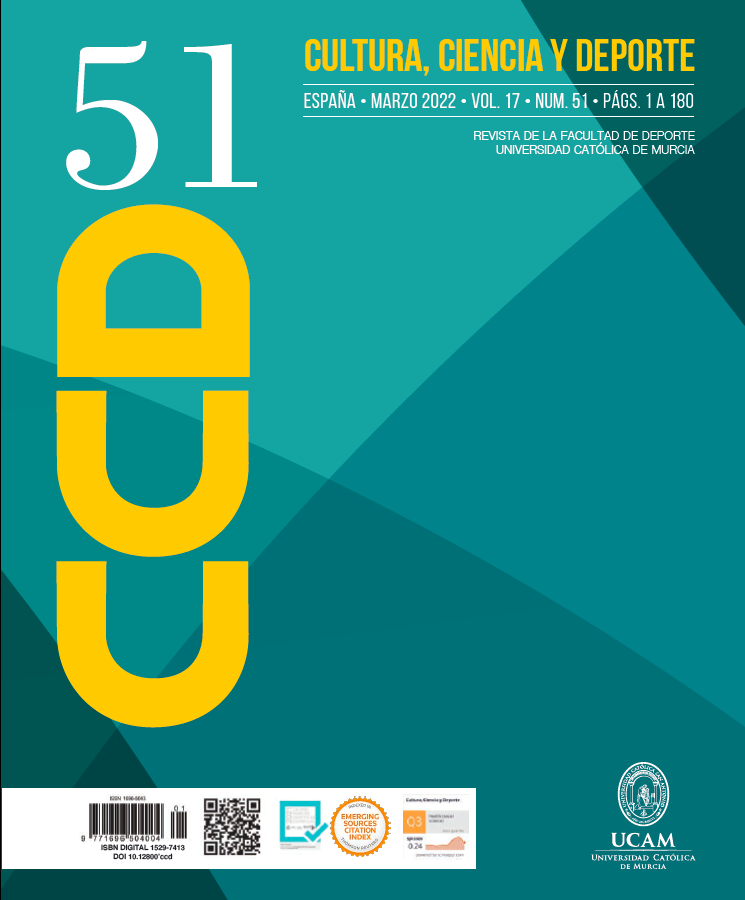Tactical performance of talented youth soccer players
DOI:
https://doi.org/10.12800/ccd.v17i51.1721Keywords:
sport initiation, gifted, education, decision-making, invasion gameAbstract
The evaluation of talented soccer players has been based, traditionally, in isolated technical tests. However, the tactical side has now gained more importance. For that reason, the purpose of this work has been twofold. First, to examine the evolution of the tactical performance of a group of talented players previously selected. Secondly, to compare the tactical performance between talented and non-talented players. A total of 607 tactical sequences were evaluated. These players were selected from an initial sample of 104 soccer players aged 14–23 years (17.03±2.01). The Nomination Scale for identifying Football Talent and the FUT-SAT instrument were used. The results indicated that the tactical principle Width and Length are the most used in the offensive phase, while Defensive Unity is the most frequent in the defensive phase. The effectiveness of the tactical principles decreases from U-16 to U-23. Finally, there is a greater percentage of efficacy in the use of tactical principles with talented players. It is concluded that talented soccer players have a better tactical acquisition in the offensive phase than the defensive. So, the precocity in tactical acquisition of these players must be considered when designing training sessions.
References
Ali, A. (2011). Measuring soccer skill performance: a review. Scandinavian journal of medicine & science in sports, 21(2), 170-183. http://dx.doi.org/10.1111/j.1600-0838.2010.01256.x
Araújo, D., Hristovski, R., Seifert, L., Carvalho, J., & Davids, K. (2017). Ecological cognition: expert decision-making behaviour in sport. International Review of Sport and Exercise Psychology, 1-25. http://dx.doi.org/10.1080/1750984X.2017.1349826
Araújo, R., Mesquita, I., Hastie, P., & Pereira, C. (2016). Students’ game performance improvements during a hybrid sport education–step-game-approach volleyball unit. European Physical Education Review, 22(2), 185-200. http://dx.doi.org/10.1177/1356336X15597927
Bailey, R. & Collins, D. (2013). The standard model of talent development and its discontents. Kinesiology Review, 2(4), 248-259. http://dx.doi.org/10.1123/krj.2.4.248
Brito, R., De Oliveira, V., Moreira, G., Julio, C., Da Costa, I. T., & Juan, P. (2015). Avaliaçao do comportamento tático no futebol: Princípios táticos fundamentais nas categorias Sub-14 e Sub-15 Revista Brasileira de Ciência e Movimento, 23(2), 59-65. http://dx.doi.org/10.18511/0103-1716/rbcm. v23n2p59-65
Bueno, H., Figueiredo, G., & Costa, I. T. (2013). Comparação do comportamento tático de jogadores de futebol entre categorias sub-11 e sub-17. Revista Mineira de Educação Física, 715-721.
Baker, J., Schorer, J., & Wattie, N. (2017). Compromising talent: issues in identifying and selecting talent in sport. Quest, 1-16. http://dx.doi.org/10.1080/00336297.2017.1333438
Chittle, L., Horton, S., & Dixon, J. C. (2018). Relative age effects and academic timing in Canadian interuniversity football. High Ability Studies. 1-14. http://dx.doi.org/10.1080/13598139.2017.1423042
Costa, I., Garganta, J., Greco, P., Mesquita, I., & Maia, J. (2011). System of tactical assessment in Soccer (FUT-SAT): Development and preliminary validation. Motricidade, 7(1), 69-83. http://dx.doi.org/10.6063/motricidade.7(1).121
Correia, D., Teoldo, V., Casanova, F., Clemente, F. M., & Teoldo, I. (2019). Comparison between teams of different ranks in small-sided and conditioned games tournaments, International Journal of Performance Analysis in Sport, 19(4), 608-623, http://dx.doi.org/10.1080/24748668.2019.1643598
Christensen, M. K., & Sorensen, J. K. (2009). Sport or school? Dreams and dilemmas for talented young Danish football players. European Physical Education Review, 15(1), 115-133. http://dx.doi.org/10.1177/1356336X09105214
Figueiredo, G., Gonçalves, E., & Costa, I. T. (2013). Comparação entre o comportamento tático de jogadores de futebol das categorias sub-11 e sub-13. Revista Mineira de Educacao Fisica (UFV), 9, 701-707.
Ford, P. R., Carling, C., Garces, M., Marques, M., Miguel, C., Farrant, A., & Salmela, J. H. (2012). The developmental activities of elite soccer players aged under-16 years from Brazil, England, France, Ghana, Mexico, Portugal and Sweden. Journal of sports sciences, 30(15), 1653-1663. http://dx.doi.org/10.1080/02640414.2012.701762
Forsman, H., Blomqvist, M., Davids, K., Liukkonen, J., & Konttinen, N. (2016). Identifying technical, physiological, tactical and psychological characteristics that contribute to career progression in soccer. International journal of Sports Science & Coaching, 11(4), 505-513. http://dx.doi.org/10.1177/1747954116655051
Gadžić, A., Milojević, A., Stanković, V., & Vučković, I. (2017). Relative age effects on motor performance of seventh-grade pupils. European Physical Education Review, 23(4), 534-542. http://dx.doi.org/10.1177/1356336X16671696
García-López, L. M., González-Víllora, S., Gutiérrez, D., & Serra, J. (2013). Development and validation of the Game Performance Evaluation Tool (GPET) in soccer. Sport TK: Revista Euroamericana de Ciencias del Deporte, 2(1), 89-99.
González-Víllora, S., García-López, L. M., & Contreras-Jordán, O. R. (2015). Decision Making and Technical Skills Evolution in Football. International Journal of Medicine and Science of Physical Activity and Sport, 59, 467-487. http://dx.doi.org/10.15366/rimcafd2015.59.005
González-Víllora, S., Serra-Olivares, J., Pastor-Vicedo, J. C., & Costa, I. T. (2015). Review of the tactical evaluation tools for youth players, assessing the tactics in team sports: football. SpringerPlus, 4(1), 663. http://dx.doi.org/10.1186/s40064-015-1462-0
Gutierrez, D., & Garcia-Lopez, L. M. (2012). Gender differences in game behaviour in invasion games. Physical Education & Sport Pedagogy, 17(3), 289-301. http://dx.doi.org/10.1080/17408989.2012.690379
Gutierrez, D., Pastor-Vicedo, J.C., Gonzalez-Villora, S. & Contreras-Jordan, C. (2010). The relative age effect in youth soccer players from Spain. Journal of Sports Science and Medicine, 9(2), 190-198.
Hastie, P.A., Calderón, A., Palao, J. & Ortega. E. (2011). Quantity and quality of practice: Interrelationships between task organization and student skill level in physical education. Research Quarterly for Exercise and Sport, 82(4), 784-787. http://dx.doi.org/10.1080/02701367.2011.10599815
Holt, N. L. (2002). A comparison of the soccer talent development systems in England and Canada. European Physical Education Review, 8(3), 270-285. http://dx.doi.org/10.1177/1356336X020083006
Hornstra, L., Van der Veen, I., & Peetsma, T. (2017). Effects of full-time and part-time high-ability programs on developments in students’ achievement emotions. High Ability Studies, 28(2), 199-224. http://dx.doi.org/10.1080/13598139.2017.1332575
Houlihan, B. (2000). Sporting excellence, schools and sports development: The politics of crowded policy spaces. European physical education review, 6(2), 171-193. http://dx.doi.org/10.1177/1356336X000062005
Kirk, D. (2005). Physical education, youth sport and lifelong participation: the importance of early learning experiences. European Physical Education Review, 11(3), 239-255. http://dx.doi.org/10.1177/1356336X05056649
Kirk, D., & Gorely, T. (2000). Challenging thinking about the relationship between school physical education and sport performance. European Physical Education Review, 6(2), 119-134. http://dx.doi.org/10.1177/1356336X000062002
Lamas, L., Drezner, R., Otranto, G., & Barrera, J. (2018). Analytic method for evaluating players’ decisions in team sports: Applications to the soccer goalkeeper. PloS One, 13(2), e0191431. http://dx.doi.org/10.1371/journal.pone.0191431
Light, R., & Tan, S. (2006). Culture, embodied experience and teachers’ development of TGfU in Australia and Singapore. European Physical Education Review, 12(1), 99-117. http://dx.doi.org/10.1177/1356336X06060659
Liu, H., Gomez, M. Á., Lago-Peñas, C., & Sampaio, J. (2015). Match statistics related to winning in the group stage of 2014 Brazil FIFA World Cup. Journal of Sports Sciences, 33(12), 1205-1213. http://dx.doi.org/10.1080/02640414.2015.1022578
Machado, G. & Teoldo, I, (2019). TacticUP: Validação de construto de um teste para avaliação do conhecimento tático declarativo de jogadores de futebol. Anais 7ºSoccer Experience – Tática. Revista Brasileira de Futebol, ISSN: 1983-7194
Morley, D., McKenna, J., Gilbert, S., French, J., Till, K., Quarmby, T., & Turner, G. (2017). Can’t pay, can’t play? Talent lead’s perspectives on the financial constraints experienced by athletes on the England Talent Pathway. High Ability Studies, 1-14. http://dx.doi.org/10.1080/13598139.2017.1341389
Murr, D., Raabe, J., & Höner, O. (2018). The prognostic value of physiological and physical characteristics in youth soccer: A systematic review. European journal of sport science, 18(1), 62-74. http://dx.doi.org/10.1080/17461391.2017.1386719
Nicolairé, A. H., Cattuzzo, M. T., & De Mello, C. B. (2013). Questionable use of performance testing to predict success in soccer players: comment on Ljach, et al. (2012). Perceptual and Motor Skills, 116(1), 352-354. http://dx.doi.org/10.2466/30.10.25.PMS.116.1.352-354
Pankhurst, A., & Collins, D. (2013). Talent identification and development: The need for coherence between research, system, and process. Quest, 65(1), 83-97. http://dx.doi.org/10.1080/00336297.2012.727374
Penney, D., & McMahon, J. (2016). High-performance sport, learning and culture: new horizons for sport pedagogues?. Physical Education and Sport Pedagogy, 21(1), 81-88. http://dx.doi.org/10.1080/17408989.2015.1072511
Phillips, E., Davids, K., Renshaw, I., & Portus, M. (2010). Expert performance in sport and the dynamics of talent development. Sports medicine, 40(4), 271-283. http://dx.doi.org/10.2165/11319430-000000000-00000
Práxedes, A., Moreno, A., Gil-Arias, A., Claver, F., & Del Villar, F. (2018). The effect of small-sided games with different levels of opposition on the tactical behaviour of young footballers with different levels of sport expertise. PloS One, 13(1), e0190157. http://dx.doi.org/10.1371/journal.pone.0190157.
Prieto-Ayuso, A., Pastor-Vicedo, J. C., & Contreras-Jordán, O. (2017). Content validity and psychometric properties of the nomination scale for identifying football talent (NSIFT): Application to coaches, parents and players. Sports, 5(1), 2. http://dx.doi.org/10.3390/sports5010002
Rein, R., & Memmert, D. (2016). Big data and tactical analysis in elite soccer: future challenges and opportunities for sports science. SpringerPlus, 5(1), 1410. http://dx.doi.org/10.1186/s40064-016-3108-2
Rechenchosky, L., Borges, PH., Menegassi, VM., de Oliveira, JM., Guilherme, J., Teoldo, I., & Rinaldi, W. (2017). Comparison of tactical principles efficiency among soccer players from different game positions. Human Movement, 18(5) special/issue:31–38; doi: 10.1515/humo-2017-0040
Rodrigues, M., dos Santos, A., Greco, PJ., & Teoldo I. (2019). Association between inhibitory control and tactical performance of under-15 soccer players. Journal of Sport Psychology, 28 (1). 63–70.
Robinson, G., & O'Donoghue, P. (2007). A weighted kappa statistic for reliability testing in performance analysis of sport. International Journal of Performance Analysis in Sport. 7(1), 12-19. http://dx.doi.org/10.1080/24748668.2007.11868383
Røynesdal, Ø., Toering, T., & Gustafsson, H. (2018). Understanding players' transition from youth to senior professional football environments: A coach perspective. International Journal of Sports Science & Coaching, 13(1), 26-37. http://dx.doi.org/10.1177/1747954117746497
Sanchez-Mora, D., García, L. M., Del Valle, M., & Solera, I. (2011). Spanish primary school students' knowledge of invasion games. Physical Education & Sport Pedagogy. 16(3), 251-264. http://dx.doi.org/10.1080/17408989.2010.535195
Santos, S., Jiménez, S., Sampaio, J., & Leite, N. (2017). Effects of the Skills4Genius sports-based training program in creative behavior. PloS One, 12(2), e0172520. http://dx.doi.org/10.1371/journal.pone.0172520
Sarmento, H., Anguera, M. T., Pereira, A., & Araújo, D. (2018). Talent Identification and Development in Male Football: A Systematic Review. Sports Medicine, 1-25. http://dx.doi.org/10.1007/s40279-017-0851-7
Sarmento, H., Clemente, F. M., Araújo, D., Davids, K., McRobert, A., & Figueiredo, A. (2017). What Performance Analysts Need to Know About Research Trends in Association Football (2012–2016): A Systematic Review. Sports medicine, 1-38. http://dx.doi.org/10.1007/s40279-017-0836-6
Serra-Olivares, J., Clemente, F. M., & González-Víllora, S. (2016). Tactical expertise assessment in youth football using representative tasks. SpringerPlus, 5(1), 1301. http://dx.doi.org/10.1186/s40064-016-2955-1
Tabchnick, B., & Fidell, L. (2007). Using multivariate statistics. Boston: Allyin & Bacon.
Towlson, C., Cobley, S., Wayne Midgley, A., Garrett, A., Parkin, G., and Lovell, R. (2017). Relative Age, Maturation and Physical Biases on Position Allocation in Elite-Youth Soccer. International Journal of Sports Medicine, 38(3), 201-209. http://dx.doi.org/10.1055/s-0042-119029
Travassos, B., Araújo, D., & Davids, K. (2018). Is futsal a donor sport for football?: exploiting complementarity for early diversification in talent development. Science and Medicine in Football, 2(1), 66-70. http://dx.doi.org/10.1080/24733938.2017.1390322
Wilkinson, S., Penney, D., & Allin, L. (2016). Setting and within-class ability grouping: A survey of practices in physical education. European Physical Education Review, 22(3), 336-354. http://dx.doi.org/10.1177/1356336X15610784
Williams, A. M., & Reilly, T. (2000). Talent Identification and Development in Soccer. Journal of Sport Sciences, 18, 657-667. http://dx.doi.org/10.1080/02640410050120041
Woods, C. T., Joyce, C., & Robertson, S. (2016). What are talent scouts actually identifying? Investigating the physical and technical skill match activity profiles of drafted and non-drafted U18 Australian footballers. Journal of science and medicine in sport, 19(5), 419-423. http://dx.doi.org/10.1016/j.jsams.2015.04.013
Yiannaki, C., Carling, C., & Collins, D. (2018). Could futsal hold the key to developing the next generation of youth soccer players?. Science and Medicine in Football, 2(1), 71-74. http://dx.doi.org/10.1080/24733938.2017.1332422
Young, J. A., Symons, C. M., Pain, M. D., Harvey, J. T., Eime, R. M., Craike, M. J., & Payne, W. R. (2015). Role models of Australian female adolescents: A longitudinal study to inform programmes designed to increase physical activity and sport participation. European Physical Education Review, 21(4), 451-466. http://dx.doi.org/10.1177/1356336X15579574
Published
How to Cite
Issue
Section
License
Copyright (c) 2022 Creative Commons Attribution License

This work is licensed under a Creative Commons Attribution-NonCommercial-ShareAlike 4.0 International License.
The authors who publish in this journal agree with the following terms:
- The authors retain the copyright and guarantee the journal the right to be the first publication of the work as well as licensed under a Creative Commons Attribution License that allows others to share the work with recognition of the authorship of the work and the initial publication in this journal.















